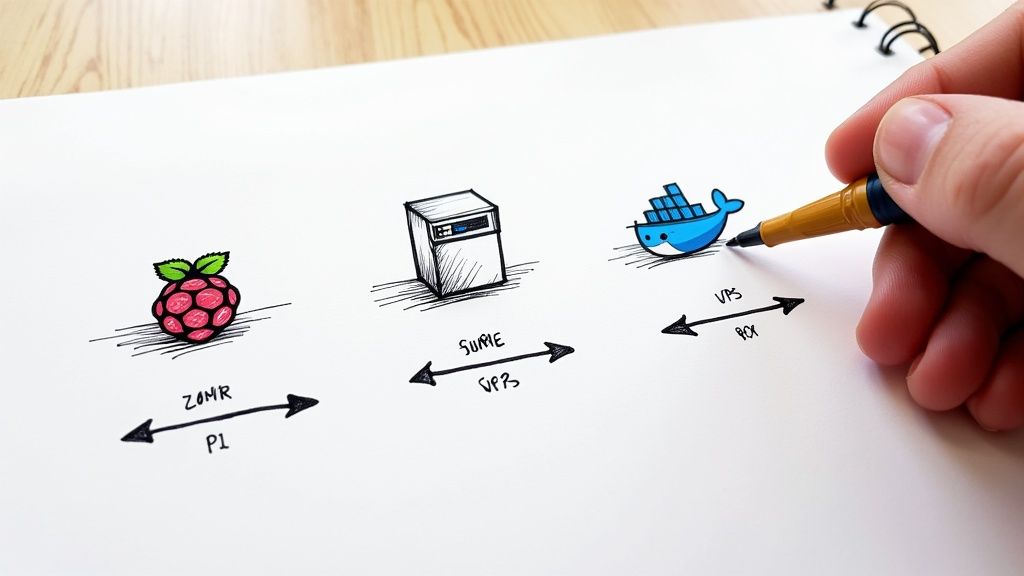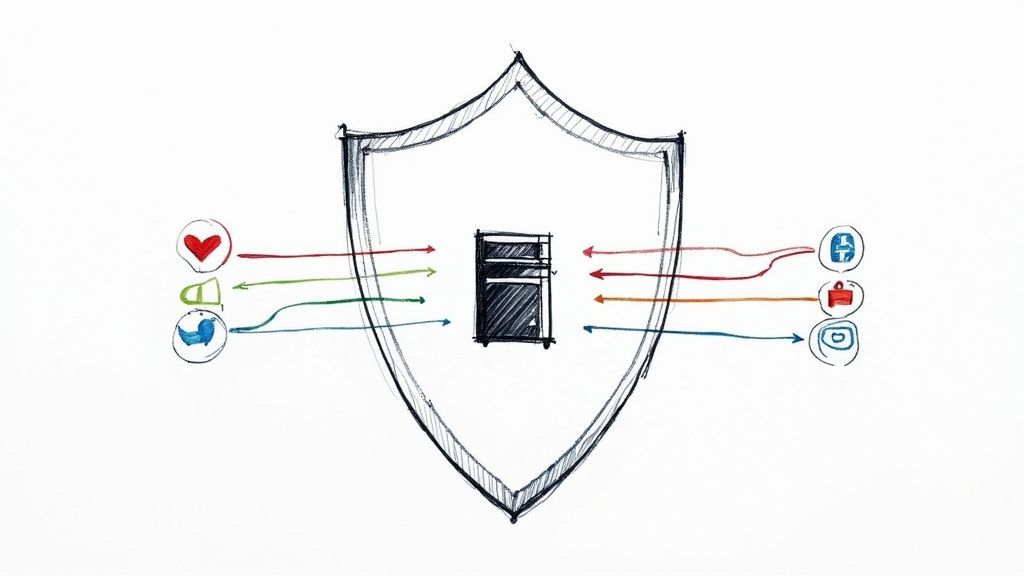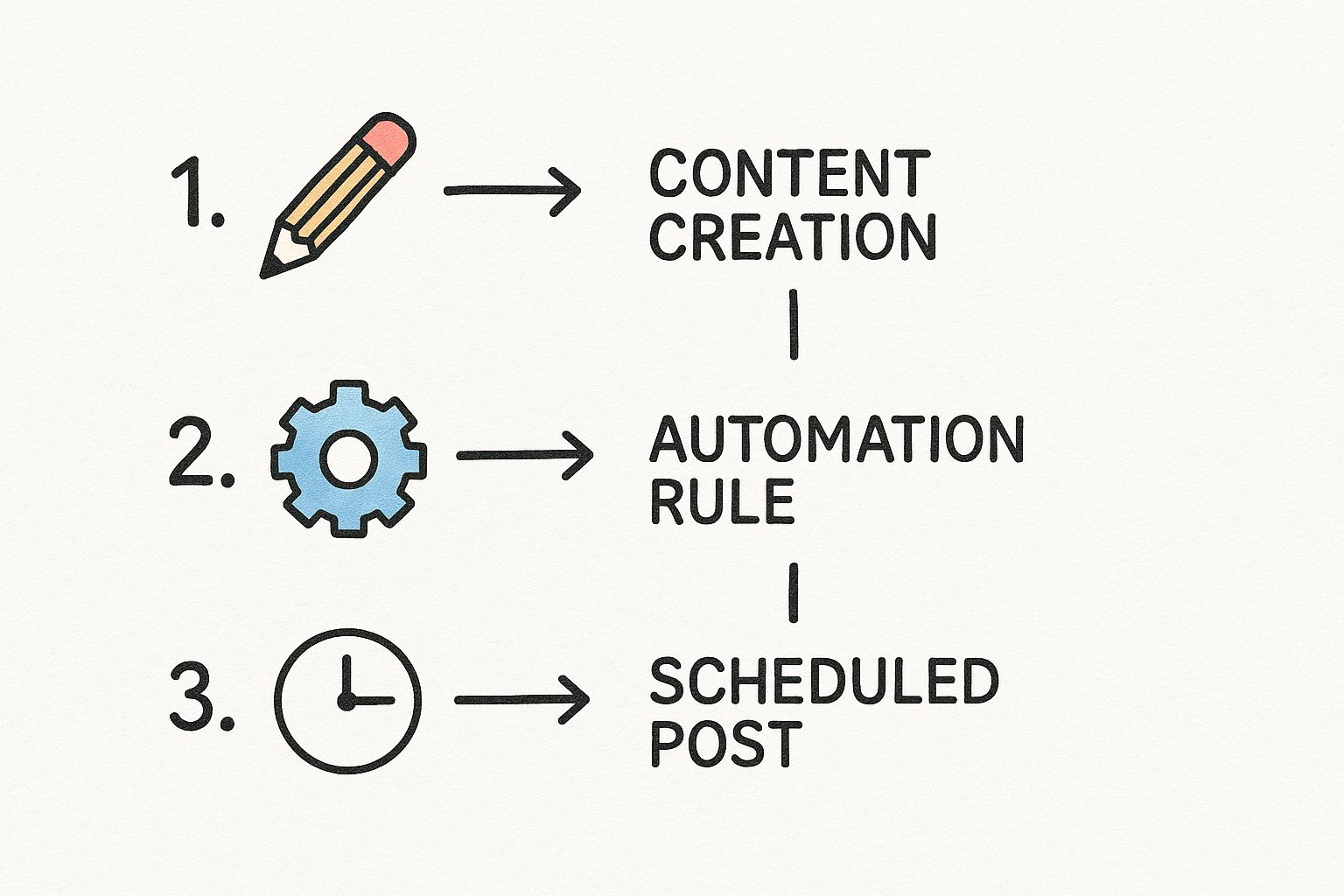Understanding Self-Hosted Social Media Management
Imagine your social media management tools are like a well-stocked toolbox. You could rent tools from the hardware store (that's like using standard Software as a Service, or SaaS platforms) each time you need them. Or, you could invest in your own tools and keep them in your own workshop (that's self-hosting). Self-hosting means the software lives on your servers, offering a greater level of control and flexibility.

Benefits of Owning Your Social Media Toolkit
Having your own social media toolkit brings some real advantages. Think about customizing it: with self-hosting, you're not limited by the features a third-party provider offers. You can adapt and expand your setup to precisely match your needs.
You also have direct access to your data. This is like having a detailed inventory of your toolshed, letting you analyze usage, identify trends, and gain valuable insights without relying on external reports. Plus, it allows for smoother integration with other systems, like your CRM (HubSpot) or marketing automation platform. Everything works together, just like a well-organized workshop.
Deployment Options: Finding the Right Fit
Self-hosting offers a variety of deployment options. Think of it as choosing the right workshop space.
-
Managed hosting services: This is like renting a fully equipped workshop. Someone else handles the technical maintenance (servers, security, etc.), leaving you free to focus on your projects (social media strategy).
-
Cloud-based self-hosting: This is like building your workshop on a flexible, expandable platform. You have the space you need, and you can easily scale up or down as your projects grow.
-
On-premises solutions: This is like constructing your workshop on your own land. You have complete control over every aspect, ideal for maximum security and compliance.
In the world of self-hosted social media management, taking control of your content is becoming increasingly important. Tools like Mixpost help you create, schedule, and manage your social media presence all in one place, without recurring subscription fees and with unlimited usage.
Security Considerations: Protecting Your Assets
Security is paramount, just like protecting your valuable tools. With self-hosting, you're in charge of security. This means implementing strong measures tailored to your setup.
-
Strong authentication: This is like having a secure lock on your workshop door, preventing unauthorized access.
-
Regular software updates: This is like regularly maintaining your tools, patching vulnerabilities and keeping everything in top working condition.
-
Data backups and disaster recovery: This is like having insurance for your workshop and tools. If something unexpected happens, you can recover quickly and continue your work.
By owning your security, you reduce risks and build a robust, protected environment for your social media activities – a level of control that’s often not possible with third-party platforms. You decide what security measures best suit your needs, not someone else.
The Real Cost of Platform Dependency
Think about those monthly subscriptions you pay for social media management tools. Each one might seem like a small expense, like grabbing a coffee each day. But these costs add up. For a typical marketing agency, they can easily reach $2,400 or more annually. And the truth is, the actual cost goes far beyond the sticker price. The real expense lies in the platform dependency that these tools create, effectively tying your business to the decisions of external providers.
Let's say your agency relies heavily on a platform like Buffer. What happens if they suddenly decide to raise their prices or drastically change a key feature? You’re forced to adapt, whether or not those changes fit your workflow or your budget. This lack of control can stifle innovation and limit your ability to respond effectively to market shifts. Imagine a consultant losing years of valuable analytics because they switched platforms. This is not a hypothetical scenario; it’s a real risk.
The Hidden Costs of Vendor Lock-in
This dependence has implications beyond just money. Vendor lock-in can create data silos, making it harder to access your own information and integrate with other business tools. Feature restrictions might prevent you from implementing unique strategies or customizing campaigns for specific clients. The popularity of platforms like Facebook and Instagram (cited by 29% of marketers as the most effective) has a huge impact on how businesses approach self-hosted solutions. Seamless integration with these platforms is essential for maximizing ROI. And with the average person using 6.83 different social networks every month, efficiently managing multiple accounts becomes crucial. Self-hosted solutions offer a centralized interface to handle this complexity. Discover more insights into current social media trends.
To illustrate the long-term financial impact of choosing a SaaS solution versus a self-hosted platform, let's look at a cost comparison table.
Traditional SaaS vs Self-Hosted Social Media Management Cost Comparison
A comprehensive comparison showing the total cost of ownership over time between subscription-based platforms and self-hosted solutions.
| Feature | Traditional SaaS | Self-Hosted Solution | Long-term Impact |
|---|---|---|---|
| Initial Cost | Low | Moderate (initial setup and software license) | SaaS appears cheaper upfront |
| Monthly/Annual Fees | Recurring subscription fees | Minimal (server maintenance, potential upgrades) | Self-hosted costs less over time |
| Data Ownership | Limited | Full control | Self-hosted offers better data security and portability |
| Feature Customization | Restricted to platform offerings | Highly customizable | Self-hosted adapts to specific business needs |
| Scalability | Dependent on SaaS provider's plans | Flexible, controlled by the business | Self-hosted scales more efficiently as the business grows |
| Vendor Lock-in | High risk | Low risk | Self-hosted avoids dependence on a single provider |
As you can see, while the initial investment for self-hosting may seem higher, the long-term benefits in terms of cost savings, data control, and flexibility are substantial.
Breaking Free From Platform Constraints
Self-hosted social media management offers an escape from this dependence trap. It's about taking control of your tools, your data, and your future. By moving to a self-hosted solution, businesses regain control over their workflows, data, and scalability. Articles like Bluesky vs. Threads offer a compelling comparison of emerging decentralized platforms, highlighting the growing trend towards greater user control. This allows them to react quickly to market changes, integrate new technologies, and create customized solutions that truly meet their needs, ultimately leading to long-term growth and sustainability.
Choosing Your Self-Hosting Approach
Self-hosting your social media management is a bit like choosing how to acquire a house. Do you want a move-in ready home, a fixer-upper you can personalize, or the freedom (and work) of building from scratch? Each approach to self-hosting caters to different needs, budgets, and technical know-how. Let's explore the options.
Managed Hosting Services: The "Move-In Ready" Approach
Think of managed hosting services as a fully furnished, expertly maintained apartment. The provider takes care of all the technical complexities – server maintenance, security updates, the works – while you focus on your social media strategy. This option gives you the control of self-hosting without needing deep technical expertise. It's perfect for businesses that want the benefits of ownership without the headaches of server administration.
Cloud-Based Self-Hosting: The "Fixer-Upper" Approach
Imagine buying a house with "good bones"—solid potential you can renovate to fit your style. That’s cloud-based self-hosting. You pick the infrastructure and services you need, paying only for what you use. As your needs change, your setup can scale right along with you. This approach works well for growing agencies that want more control and scalability but don’t want to deal with managing physical hardware. It’s a good balance of freedom and convenience.
On-Premises Solutions: Building From Scratch
If cloud-based hosting is like renovating, on-premises solutions are like building your dream house from the ground up. You own and manage all hardware and software. This gives you the most control and the highest level of customization, but it requires significant technical expertise and resources. It’s the best choice for businesses with stringent security or compliance requirements, where having absolute data control is paramount.

This screenshot shows the RSSHub GitHub repository, an open-source RSS feed aggregator. It showcases the collaborative nature of open-source projects. Notice the project’s description, contributors, and resources—all freely available. This transparency and accessibility empower users to understand and even contribute to the software, a key benefit of open-source, relevant to self-hosted solutions like Postiz.
Hybrid Approaches and Practical Considerations
Maybe you want a condo with a small garden—a bit of both worlds. Combining elements of different hosting approaches is entirely possible. Hybrid models let you take advantage of the strengths of each. For instance, you might use cloud services for some functions while keeping sensitive data on-premises.
No matter which path you choose, a few important factors deserve consideration:
-
Backup Strategies: Regular backups are your safety net. They protect your data and ensure you can recover from unexpected problems. Think of it like having backups of your important tools in case of a workshop fire.
-
Update Management: Keeping your software up-to-date is like regularly sharpening your tools. It patches security holes and keeps everything running smoothly.
-
Team Access Controls: Carefully controlling who has access to what is essential for security and collaboration. It’s similar to giving different team members specific toolboxes depending on their roles.
By carefully weighing these factors, you can craft a self-hosted social media management solution that perfectly fits your unique needs, giving you optimal control, flexibility, and paving the way for long-term success. You’re building a system that empowers your social media strategy for years to come.
Security Without the Paranoia
Let's talk security for your self-hosted social media management. It doesn't need to be a Fort Knox operation. Instead of impenetrable walls and laser grids, think smart, practical measures that don't get in the way of your actual work. Like securing your home – good locks and an alarm system are key, but you probably don't need a security detail. This section will help you focus on the security steps that really make a difference.
The Non-Negotiables: Foundation of Security
First, the essentials. Think of these as the foundation of your security house: secure hosting, regular updates, and strong authentication. Secure hosting means picking a provider (or setting up your own infrastructure) with security as a priority. This includes things like firewalls, intrusion detection, and making sure your server settings are locked down. It’s all about protecting your system from outside threats.
Regular updates are like routine maintenance for your car. They keep everything running smoothly and fix any security holes. Outdated software is like a welcome mat for attackers, so keeping everything up to date is crucial. Finally, strong authentication. This is your front door lock – and you want it to be sturdy. Simple passwords aren't enough. Consider two-factor authentication (2FA) or even multi-factor authentication (MFA) for an extra layer of protection against unwanted guests.
Practical Security for Social Media Management
Beyond the basics, let’s look at securing your actual social media activity. Protecting your client social media accounts starts with individual, strong passwords for each one. A password manager can be a lifesaver here, keeping all those complex passwords organized and secure. Just as important? Limiting access. Only authorized team members should have the keys to these accounts. Role-based access controls are your friend here, letting you give access based on individual responsibilities.
Now, let's talk about who gets into your self-hosted platform itself. Again, strong passwords and 2FA are essential. Regularly check who has access and revoke permissions for anyone who no longer needs them. It's like changing the locks when someone moves out.
Data Privacy and Backup Strategies
Data privacy is a big piece of the security puzzle. This means making sure your self-hosted setup follows all the rules and regulations, like GDPR. Encrypting sensitive data adds another layer of security, making it unreadable to prying eyes.
Finally, backups. Think of these as your insurance policy. Regularly back up your data to a safe, offsite location. This lets you bounce back quickly if you lose data because of a hardware failure, an accidental deletion, or even a security breach. Having a disaster recovery plan is another good idea – a step-by-step guide for getting back on your feet in a worst-case scenario.
By taking these practical security steps, you can build a secure self-hosted social media management system without needing a cybersecurity degree. It's all about balance – strong security that doesn't tie your hands, letting you focus on what matters most: managing and growing your social media presence.
The Market Opportunity Nobody's Talking About

Imagine a crowded marketplace, everyone shouting their wares, but all selling very similar things. That's a lot like social media today. Most businesses compete on the same platforms using the same tools, leading to a sea of sameness. This creates a huge gap: a real need for authenticity and personalized experiences. That’s where self-hosted social media management steps in, offering a powerful way to stand out.
The Power of Authenticity and Personalization
Think about what's trending now: genuine storytelling, interacting in real time, and controlling your own data. These aren’t just trendy terms. They're what makes marketing effective today. Customers want authentic connections and personalized content. Businesses need the tools to provide these. This is where self-hosted solutions excel. They offer the flexibility and control you need to build unique, targeted campaigns that truly resonate with your audience. Perhaps this sounds familiar: Social Media MCP.
Early adopters of self-hosted management are already seeing the benefits. They're tailoring their processes, integrating their own data, and creating content experiences their competitors simply can't match. This gives them a real advantage in a market where standing out is everything. They aren’t just managing social media, they're shaping it.
Capitalizing on the Untapped Potential
Social media use is exploding. By 2025, there will be an estimated 5.04 billion active users worldwide. This is a massive opportunity for businesses to connect with their target audiences. Think about it: with people spending an average of 2 hours and 26 minutes on social media every day, the potential for real engagement through self-hosted management is enormous. Discover more insights. As audiences look for more authenticity and platforms prioritize real conversations, businesses need to adapt. Self-hosted management tools help this by enabling more personalized, data-driven content creation and distribution.
Empowering Agencies and Building Stronger Client Relationships
For agencies, self-hosted tools offer a way to provide better service, charge more, and build stronger client relationships. By owning their entire social media management system, they have complete control over every aspect of their clients’ social media presence. This translates to improved results, happier clients, and, in the end, a more sustainable and profitable business. They aren’t just offering a service, they're offering a partnership. They’re not just managing social media; they’re owning it. This move toward self-hosted management isn't just a passing trend; it’s a fundamental shift in how businesses think about social media, and it creates a significant market opportunity for those who embrace it.
Making the Switch: Implementation That Actually Works
Moving from the concept of self-hosted social media management to actually using it can feel a bit like planning a cross-country road trip. You need more than just the desire to go; you need a detailed map, a well-maintained car, and a plan for when things inevitably don't go as planned. This section provides that roadmap, guiding you through each step of implementing a self-hosted system.
Evaluating Your Current Setup
Before diving into any changes, it's crucial to take stock of your current social media tools and workflows. Think of it as checking your car’s oil and tire pressure before a long journey. Identify any pain points, inefficiencies, or missing features that self-hosting could potentially solve. Are you bumping up against platform limitations? Dealing with data silos? Wincing at escalating subscription costs? Understanding your current challenges helps you choose the right self-hosted solution and tailor it to your unique needs.
Planning Your Migration Strategy
With a clear picture of your current situation, you can now develop a detailed migration plan – your road trip itinerary. This plan should cover everything from data migration and team training to rigorous testing. Imagine a marketing agency successfully moving over 50 client accounts to a self-hosted platform over a single weekend, without missing a single scheduled post. This kind of seamless transition is the result of meticulous planning and anticipating potential roadblocks. Having solutions ready beforehand minimizes downtime and makes for a smooth transition. For more on workflow optimization, check out our article about marketing workflow management.
The infographic below visualizes a simplified self-hosted social media management workflow:

This streamlined approach, from content creation to scheduled posting, showcases the efficiency and control offered by self-hosted solutions like Postiz. Handling these stages internally gives businesses greater flexibility and agility in their social media strategies.
Executing the Transition and Ongoing Optimization
Implementing self-hosted social media management isn't a one-and-done affair. Much like a road trip requires occasional stops for fuel and snacks, your self-hosted system needs ongoing maintenance, updates, and optimizations. This includes monitoring system performance, gathering user feedback, and adapting to your business’s ever-changing needs.
One common mistake is underestimating the intricacies of data migration. It's not simply moving files from point A to point B; it's about ensuring data integrity and compatibility. Thorough testing and validation are crucial to prevent data loss during the transition. Think of it like carefully packing your belongings for a move – you want everything to arrive safe and sound.
Team training is another vital ingredient for success. Your team needs to be comfortable and proficient with the new system. Provide ample training and support to ensure a smooth transition and encourage adoption. Empower your team to fully leverage the self-hosted platform’s capabilities.
To help visualize the implementation process, let's look at a sample timeline:
Introduction to Implementation Timeline and Milestones: This table outlines the key phases, deliverables, and success metrics for implementing a self-hosted social media management system.
| Phase | Duration | Key Activities | Success Metrics |
|---|---|---|---|
| Assessment & Planning | 2 Weeks | Audit existing tools, define requirements, select platform | Documented requirements, platform chosen |
| Setup & Configuration | 4 Weeks | Install platform, configure settings, migrate data | System configured, data migrated |
| Training & Testing | 2 Weeks | Team training, system testing, pilot program | User proficiency, bug-free pilot |
| Launch & Optimization | Ongoing | Go-live, performance monitoring, ongoing refinement | System stability, user satisfaction |
Key Insights from the Timeline: As the table shows, implementing a self-hosted solution is a structured process that requires careful planning and execution across various phases. Ongoing optimization is critical for maximizing the benefits.
By following a well-defined roadmap, learning from the experiences of others, and focusing on continuous improvement, you can ensure your self-hosted social media management solution delivers on its potential from the outset. You’ll be navigating the social media landscape with the confidence and control you need to thrive.
Your Action Plan for Social Media Independence
Taking control of your social media management with self-hosting isn't just about switching software; it's about taking the reins of your online presence. Think of it like building your own house instead of renting – you have more freedom, control, and the ability to customize things exactly how you want. Businesses making this switch aren't just saving money; they're investing in their long-term success. Here's a practical action plan to get you started.
Assess Your Current Social Media Landscape
Before you build, you need to survey the land. Take an honest look at your current social media management. Are rising software fees cutting into your budget? Do the limitations of the platform feel like a creative straitjacket? Are you worried about the security and ownership of your data in the hands of a third party? Pinpointing your pain points is the first step towards building a stronger, more independent approach.
Building Your Business Case
If you're part of a team, you might encounter some hesitation about change. Explain the benefits of self-hosted social media management clearly to everyone involved. Focus on the long-term cost savings, the improved security, and the increased control you'll have over your data and how you work. Show how self-hosting aligns with your company's overall goals. Imagine presenting it as an investment that pays off in more ways than one.
Choosing the Right Self-Hosted Solution
Just like choosing the right building materials for your house, picking the right self-hosted solution matters. Not all platforms are created equal. Explore different options, considering factors like the features they offer, how easy they are to use, whether they can grow with you, and the support available from the community. Postiz, for example, offers a robust platform with features designed for both individual creators and large teams. The screenshot below shows the Postiz interface:
The Postiz dashboard provides a clear and organized view of essential social media management features. It’s like having a central command center for your social media, streamlining content scheduling, performance tracking, and team collaboration all in one place.
Creating Your Implementation Timeline
Once you've chosen your platform, create a realistic timeline for the transition. This timeline should include important steps like migrating your data, training your team, and testing the system. Give yourself enough time for each step to avoid a rushed and potentially disruptive process. Think of it like a project plan with clear phases and deadlines.
Measuring Success and Planning for Growth
After the transition, track key measurements like how much you're saving, how engaged your audience is, and your overall efficiency. Use this data to refine your strategy and get the most out of your self-hosted setup. Think of it like checking the foundation and structure of your new house regularly to ensure stability. Also, consider future growth. Choose a solution that can scale with your business so your social media management remains flexible and adaptable as you expand.
Whether you're ready to move next month or just beginning to explore, a clear plan is crucial. Self-hosted social media management gives you the power to own your data, control your message, and build a truly independent social media presence. Ready to take control? Explore the power of self-hosted social media management with Postiz. Start building your independent social media strategy today.





